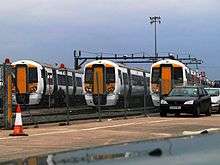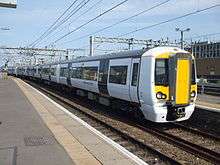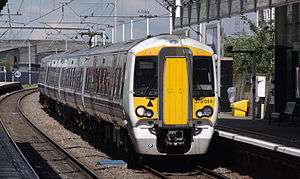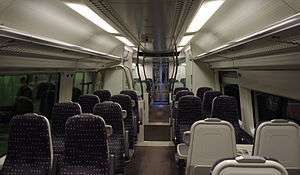British Rail Class 379
| British Rail Class 379 Electrostar | |
|---|---|
|
Abellio Greater Anglia Class 379 Electrostar EMU 379014 arrives at Tottenham Hale with a service to Liverpool Street. | |
|
Interior of 379021 at London Liverpool Street. | |
| In service | 17 March 2011 - Current |
| Manufacturer | Bombardier Transportation |
| Family name | Electrostar |
| Constructed | 2010 - 2011 |
| Number built | 30 trainsets |
| Formation | 4 cars per trainset |
| Fleet numbers | 379001 - 379030 |
| Operator(s) | Abellio Greater Anglia |
| Line(s) served |
West Anglia Main Line (Stansted Express) |
| Specifications | |
| Maximum speed | 100 mph (161 km/h)[1] |
| Traction system |
IGBT-VVVF (Bombardier MITRAC DR1000) |
| Electric system(s) | 25 kV 50 Hz AC Overhead |
| Current collection method | Pantograph |
| Track gauge | 1,435 mm (4 ft 8 1⁄2 in) standard gauge |
The Class 379 Electrostar is a British electric multiple unit train type ordered in April 2009 for Stansted Express services operated by National Express East Anglia (NXEA)[2][3] and later Abellio Greater Anglia.
The trains are also being used on services between London Liverpool Street, Bishops Stortford, Harlow Town, Stansted Airport, Cambridge, Ely and Kings Lynn.[4] The fleet was ordered as part of the NXEA Service Improvement Plan designed to expand capacity on the heavily crowded lines into London Liverpool Street.[5]
Description



The trains are part of Bombardier Transportation's Electrostar family and are owned by Macquarie European Rail. They were built at Bombardier's Derby plant, where the first unit was unveiled on 13 October 2010.[6]
After going to the Velim railway test circuit in the Czech Republic during November 2010, the first train returned to the UK in December for further testing along with other members of the class as they are built.
A phased introduction into passenger service began in March 2011.[7] They are maintained by Bombardier at Ilford.[2] They work alongside the Class 317.
Features and fitted equipment
The Class 379 units feature 2+2 seating in standard class, and 2+1 seating in first class. Large luggage racks are provided should the train be on airport services.[1]
Wi-Fi is supplied by Icomera of Sweden, not only for passenger internet use but also for linking the train's reservation, CCTV, passenger information and monitoring systems to the control room.[5]
The trains have regenerative braking[6] and use Bombardier's Orbita predictive fault monitoring system.[1] Some features are taken from the upcoming Aventra.[6] Interior lighting is supplied by Teknoware and includes state-of-the-art emergency lighting to fulfil GM/RT 2130 requirements. CCTV cameras on the roof monitor the pantograph arm.[5]
Operations
The first two units, 379005 and 379006, entered service on 17 March 2011. 379005 was named Stansted Express at a ceremony at London Liverpool Street.[7] A further 18 units were to enter service in May 2011, on Stansted Express workings. They will work in a mixture of 12-car and 8-car lengths.
The remaining 10 began entering service in summer 2011 on Cambridge services. The Class 379 first ran on 3 March 2011 between Liverpool Street and Stansted Airport. All units had entered service by mid-August 2011, two months ahead of schedule and the airport services are now entirely worked by 8-car Class 379s. The December 2011 timetable change included the introduction of 12-car trains on some peak workings out of Liverpool Street to/from Bishops Stortford, Harlow Town, Ely, Kings Lynn and Cambridge. Plus on some services out of Stratford to/from Cambridge, Harlow Town and Bishops Stortford and on some Bishops Stortford/Stansted Airport-Cambridge services. They work on long distance express services. [8]
These trains are now operated by Abellio Greater Anglia as of 5 February 2012.
BEMU trial
Network Rail are using unit 379013 as a testbed for a future Battery-Electric Multiple Unit (BEMU). The unit first carried passengers on a Manningtree–Harwich Town service on 12 January 2015.[9][10][11]
Future
By 2019, the Class 379s will be replaced by a brand new fleet of Stadler FLIRT EMUs which will be fixed 12-car trains. [12]
Fleet details
| Class | Operator | No. Built | Year Built | Cars per Set | Unit nos. |
|---|---|---|---|---|---|
| Class 379 | Abellio Greater Anglia | 30 | 2010–2011 | 4 | 379001 - 379030 |
Named units
Named units are as follows: [13]
- 379005 - Stansted Express
- 379011 - Ely Cathedral
- 379012 - The West Anglian
- 379015 - City of Cambridge
- 379025 - Go Discover
References
- 1 2 3 "Stansted Airport trains under construction". Railway Gazette International. London. 21 July 2010. Retrieved 23 July 2010.
- 1 2 "Bombardier signs Stansted airport train order". Railway Gazette International. London. 2 April 2009. Retrieved 9 August 2010.
- ↑ Today's Railways issue 91
- ↑ Rail. 673. Peterborough. 29 June 2011. p. 37. Missing or empty
|title=(help) - 1 2 3 "Class 379 set to woo Stansted passengers". Modern Railways. London. December 2010. pp. 56–60.
- 1 2 3 "First new Stansted Express train rolls out". Railway Gazette International. London. 14 October 2010.
- 1 2 "National Express launches Class 379s on Stansted Express service" (PDF). Railway Herald (260). Scunthorpe. 21 March 2011. p. 3. Retrieved 8 May 2011.
- ↑ "New timetable for the West Anglia network". National Express East Anglia. Retrieved 11 November 2011.
- ↑ "Network Rail Press Release We're developing a prototype battery powered train 19 August 2013". Network Rail. Retrieved 19 August 2013.
- ↑ "On-track trials of prototype battery-powered train begin". Network Rail. 12 August 2014. Retrieved 28 September 2014.
- ↑ Clinnick, Richard. "Battery-powered Electrostar enters traffic". railmagazine.com. Bauer Consumer Media. Retrieved 13 January 2015.
- ↑ Modern Railways Magazine, September 2016 issue, pages 13-15
- ↑ "EMU Formations". AbRail. Retrieved 25 June 2015.
External links
![]() Media related to British Rail Class 379 at Wikimedia Commons
Media related to British Rail Class 379 at Wikimedia Commons

